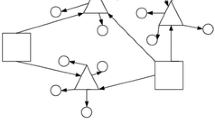Abstract
GIS network analysis function has been proved very effective in solving most network-related problems. GIS spatial analysis models such as Buffer Analysis, Overlay analysis, and so on, play very important roles in combining different logistic models. However, the education on logistic system has failed to help students to build up solid concept of logistic models due to the lack of visualization. In this paper, a GIS - based simulation software is built up and a visual and direct way on logistics study is provided. The software could be used in daily logistics education.
Access this chapter
Tax calculation will be finalised at checkout
Purchases are for personal use only
Preview
Unable to display preview. Download preview PDF.
Similar content being viewed by others
References
Hu, J.-K., Yang, B., Wang, J., Wang, Z.-H., Hao, Y.-Y., Hu, Z.-H.: GIS Based Safe Area Discovery for Emergency Logistics
Yang, B., Hao, Y.-Y., Wang, J., Hu, Z.-H.: Flexible service architecture for maritime business promotion based on mobile technology
Rashmi Kandwal, P.K., Garg, R.D.: Health GIS and HIV/AIDS studies: Perspective and retrospective. Journal of Biomedical Informatics 42, 748–755 (2009)
Al-Sabhan, W., Mulligan, M., Blackburn, G.A.: A real-time hydrological model for flood prediction using GIS and the WWW. Computers, Environment and Urban Systems 27, 9–32 (2003)
Wei, H., Xu, Q.-x., Tang, X.-s.: A knowledge-based problem solving method in GIS application. Knowledge-Based Systems 24, 542–553 (2011)
Author information
Authors and Affiliations
Editor information
Editors and Affiliations
Rights and permissions
Copyright information
© 2011 Springer-Verlag Berlin Heidelberg
About this paper
Cite this paper
Yang, B., Zhao, L., Hu, JK. (2011). Researches on Logistics Teaching Software Based on GIS. In: Lin, S., Huang, X. (eds) Advances in Computer Science, Environment, Ecoinformatics, and Education. CSEE 2011. Communications in Computer and Information Science, vol 218. Springer, Berlin, Heidelberg. https://doi.org/10.1007/978-3-642-23357-9_82
Download citation
DOI: https://doi.org/10.1007/978-3-642-23357-9_82
Publisher Name: Springer, Berlin, Heidelberg
Print ISBN: 978-3-642-23356-2
Online ISBN: 978-3-642-23357-9
eBook Packages: Computer ScienceComputer Science (R0)




